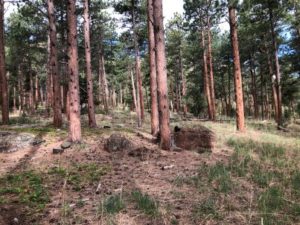
Biology I.S. research contributes to scientific understanding of melanism in Abert’s squirrels

A little black squirrel with tufted ears caught the attention of Lake Barrett ’23, not because of the tufted ears, but because the squirrel may hold a secret about melanism. The College of Wooster biology and education double major had done some research on the black squirrels in Wooster with his advisor and I.S. mentor Richard Lehtinen. When they learned that a similar black squirrel in Colorado—the Abert’s squirrel—had not been studied, Barrett saw an opportunity for research.
“It’s still a mystery, right? This was like cracking the case as an evolutionary story, and we don’t know the ending yet.”
—Lake Barrett ’23, Biology and Education majors, I.S. title: Melanism in Abert’s Squirrel: Investigating the Genetic Cause and Frequency of Melanism in Northern Populations
They had studied the Wooster black squirrels before but realized the reason there are black squirrels remains a mystery. “The way to really explore that isn’t by continuing to study the species we already have,” he said, which gave him purpose to research the yet-unstudied black squirrels of Colorado.
His research was two-fold: one, lab work to figure out “the how” or to determine if the mutation was an existing or new one, and two, traveling to Colorado to investigate the possible reasons the Colorado squirrels were black when most Abert’s squirrels in other regions were gray.
The unusually high number of black Abert’s squirrels led them to believe there must be a purpose to the melanism. Barrett’s hypotheses were the black squirrel could survive cold winters better or melanism might provide post-forest fire camouflage.
In May 2022, Barrett and Lehtinen traveled to a park near Boulder, Colorado. They monitored how many black squirrels there were versus gray ones. A study done in the early 1970s that assessed the life cycle of the squirrel species provided frequency data that about 56% of the squirrels were black and 44% gray, which Barrett could compare with what he found.
Barrett’s method of data collection included in-person counting the squirrels they saw, installing cameras that stayed up for the entire summer, utilizing the website iNaturalist, and enlisting citizen scientists as they walked in the area to snap a picture of any Abert’s squirrels they saw and send the pictures via email.
The citizen scientists proved to be the most productive method of data collection, and the overwhelming finding was that there were only black squirrels in the region where they collected data. “There doesn’t seem to be a single gray squirrel left at the park, which makes us think there has to be some benefit here,” said Barrett. “We wouldn’t expect to see this allele become fixed to the point they are all black unless there was something that made it advantageous to be black.”

Research area for squirrels studied by Lake Barrett ’23
Because the work was not an experimental setting, Barrett could not conclusively determine what caused the melanism in the Colorado Abert’s squirrel. “It could be camouflage due to the increased forest fires or the severe winters, or it could be both. The reason doesn’t necessarily have to be one or the other,” he said. “I found an entirely new mutation, which means there is not a common ancestor who had the mutation and passed it down.” The new mutation indicates the squirrel’s melanism has evolved over time providing more evidence that there is a reason behind the color change.
Barrett and Lehtinen plan to publish the research because it is “mathematically incredibly significant” considering the black squirrel population went from 50% in the 1970s to 100% now. “That’s a massive change,” Barrett said.
“What really excited me about doing this project was essentially that it mattered, I wanted to do something that makes a legitimate contribution to our understanding of something, and it definitely checked the box,” he said. “It’s still a mystery, right? This was like cracking the case as an evolutionary story, and we don’t know the ending yet.”
After a final semester at Wooster to complete student teaching in the fall and play another season of football, Barrett is considering pursuing a teaching job or applying to graduate school to continue doing research that matters.
Posted in Independent Study on May 10, 2023.
Related Posts
Related Areas of Study
Education
Graduate as a licensed teacher in pre-K-12 in fields ranging from science to music education
Major Minor Teaching LicensureBiology
Explore molecular and cellular biology, ecology and more with top faculty and access to extensive lab facilities.
Major Minor

